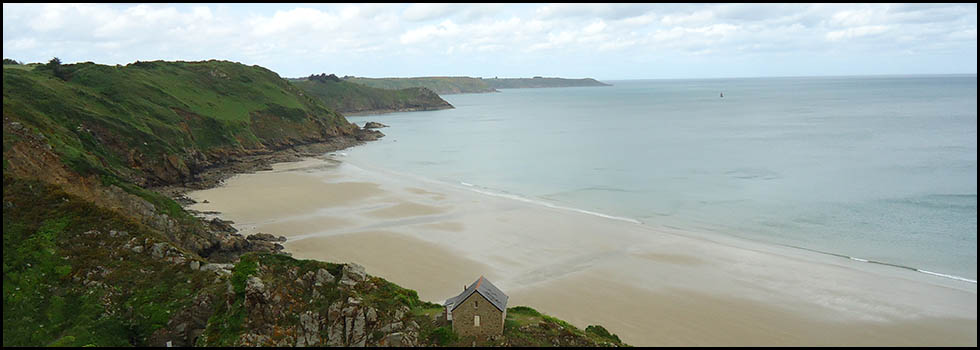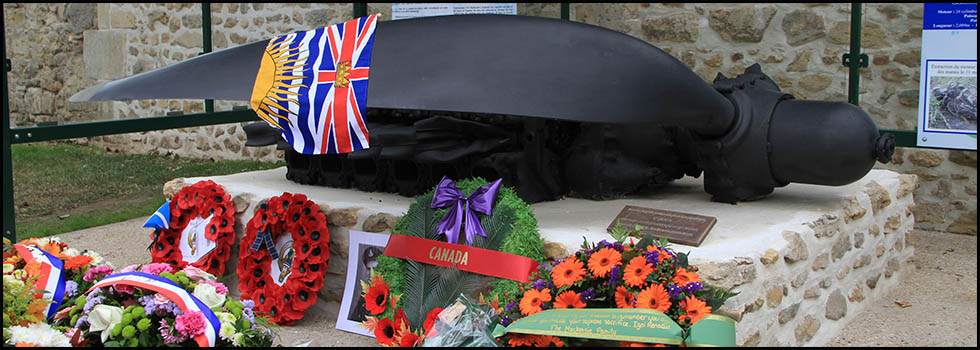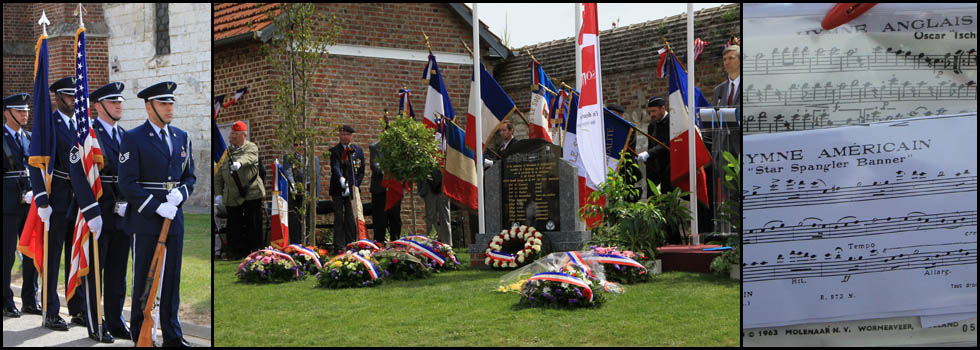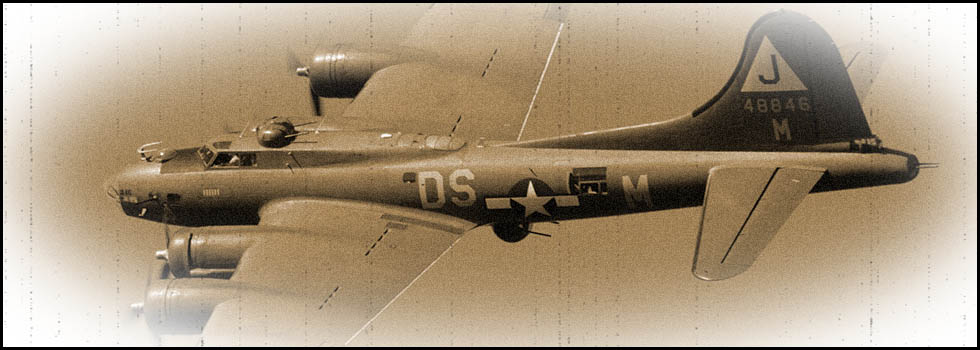18th March 1944
Appalling tragedy above the villages of
Godenvillers and Le Ployron (Oise)
392nd Bomb Group, 576th Bomb Squadron
B-24H "Liberator" # 41-29174
"Amblin'OKie"
392nd Bomb Group, 577th Bomb Squadron
8thAir Force
Copyright © 2015 - Association des Sauveteurs d'Aviateurs Alliés - All rights reserved -
En français ![]()
The mission
March 1944 - The "Round the Clock" offensive goes on. The US Army Air Force continues its daytime raids against German industries while the Bomber Command of the Royal Air Force strikes during night missions.
On 18th March 1944, the 8th Air Force conducts its 264th strategic mission. The targets are the aircraft factories, depots, and airfields located deep in German territory.
290 B-17s "Flying Fortresses" are directed at Oberpfaffenhofen, Lechfeld, Landsberg and Memmingen, in Bavaria.
221 other B-17s are directed to Munich and the aircraft factories of the sector.
227 B-24s "Liberator", 15 Bomb Groups of the 2nd Air Division, aim to bomb different aeronautical complexes including the Dornier aircraft assembly plant in Friedrichshafen, a city on the northern shore of Lake Constance, near the German-Swiss border.
28 "Liberators" of the 392nd Bomb Group based in Wendling, Norfolk, participate in this large-scale raid.
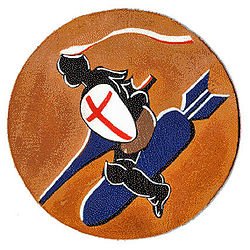
392nd Bomb Group
During the morning briefing, the crews of the 4 Squadrons of the 392nd Bomb Group learn what is to be their target. The mission turns out to be far away and at high risk above a territory heavily protected by the Luftwaffe and Flak.
After takeoff at 9:30 am, the 28 "Liberators" of the 392nd Bomb Group loaded with explosive and incendiary bombs, assemble in formations. They join the other 14 Bomb Groups which will soon begin the Channel crossing towards the target, leaving behind long vapour trails.
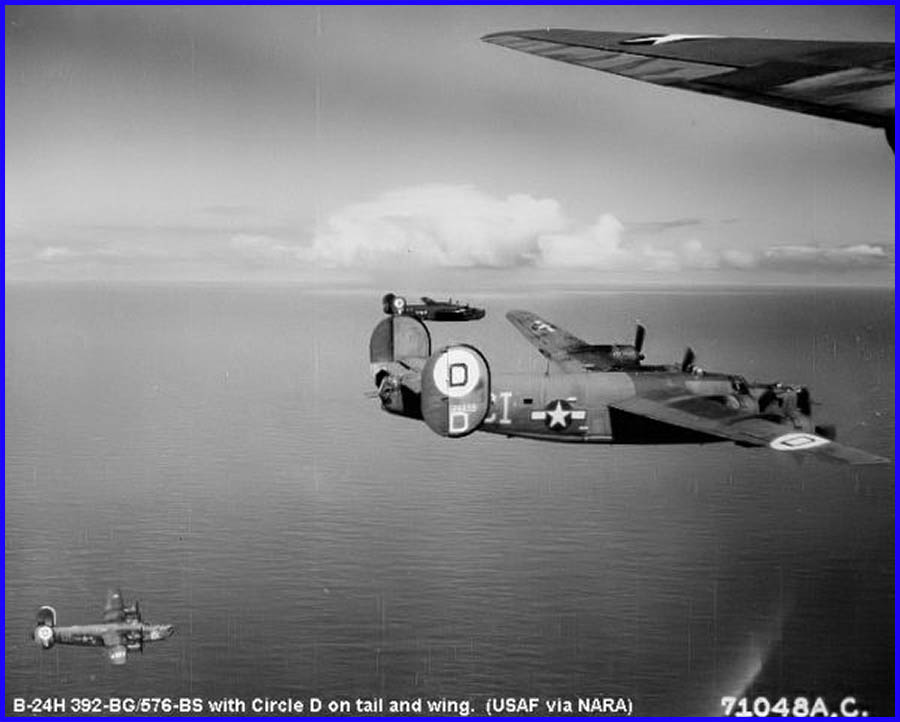
Air cover is provided by a large concentration of fighter planes (P-47, P-38 and P-51), whose role is to protect the huge armada on a part of the journey.
The weather is clear over France. Flying at 20,000 ft, wing to wing, the 392nd Bomb Group tragically lose two of its aircraft in a mid-air collision above the Oise department.
The stream of bombers continues its journey, setting course to the East in the direction of Bavaria and the target area. The blue sky is ideal for visual bombing.
The Franco-German border is crossed just to the South of Strasbourg. Soon the snow covered Alps come into view.
The aircraft progress towards the Swiss border and are close to the blue waters of Lake Constance. Bombs doors open. It is about 2:30 pm
But suddenly, all hell breaks loose. Accurate bursts of shells of the heavy Flak break up the bomber formations. Many aircraft are lost, plunging in flames to the ground.
Despite the disorganization and the many losses, the "Liberators" of the 392nd Bomb Group release their bomb load. Some of them hit the target, but others drop on the heart of the city of Friedrichshafen.
Away from the target area, the surviving bombers group together and try to make their way back to England. They are then attacked by a multitude of Messerschmitt-109 and Focke Wulf-190 fighters coming at them from out of the sun.
Allied fighters coming to the rescue disperse the attackers.
When they arrive over France, the bombers are joined by P-47s "Thunderbolt" which escort them on the way back.
This raid on Friedrichshafen turns out to be a disaster.
The 392nd Bomb Group loses 14 crews in the 28 aircraft sent on this mission. 9 bombers return to England badly damaged. Command later learns that some pilots have been able to land or to parachute above neutral Switzerland. They will be interned until the end of hostilities.
The 392nd Bomb Group were to record that day its highest casualty rate of all the war.
The 8th Air Force pays a heavy price during this mission losing a total of 15 Flying Fortresses, 28 Liberators and 13 fighters.
The terrible collision
While the formations are heading to Germany at high altitude, the sky of the Oise department is going to be the scene of an appalling tragedy involving two B-24s "Liberators" of the 392nd Bomb Group.
Around 12:30, at 23,000 ft, the tail of the aircraft piloted by 2nd Lt. John E. Feran hits the right wing and breaks rear part of the B-24 "Amblin' Okie" piloted by 2nd Lt. Gerald Dalton.
The two B-24s "Liberator" immediately become uncontrollable and dive towards the ground.
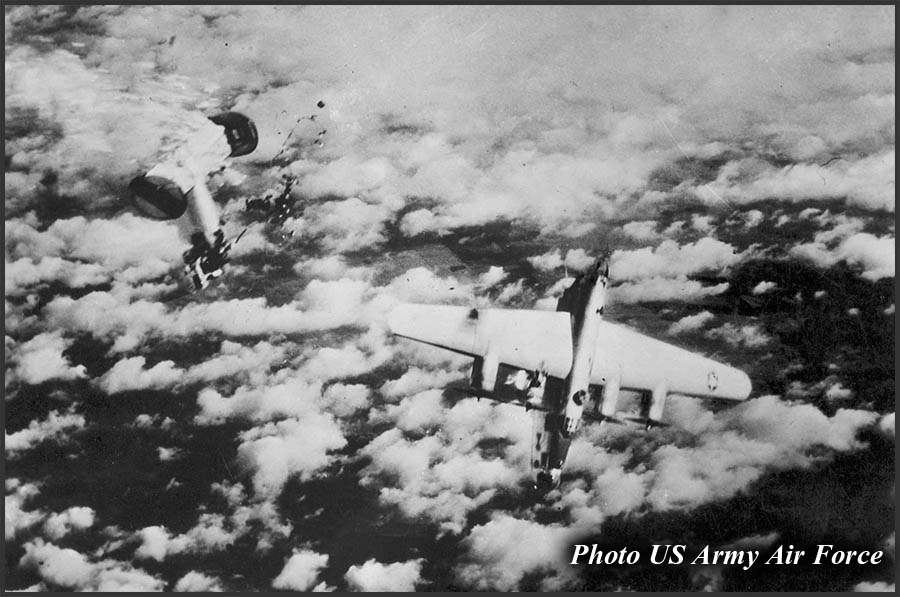
Loaded with their cargo of explosive and incendiary bombs, they go crashing to the ground a few minutes later on the outskirts of the villages of Godenvillers and Le Ployron.
The crews :
392nd Bomb Group, 576th Bomb Squadron
| 2nd Lt. John E. FERAN | Pilot | Minneapolis, Minnesota |
| 2nd Lt. Francis N. HAYES | Co-pilot | Ohio |
| 2nd Lt. Francis J. CUMMINGS | Navigator | North Braddock, Pennsylvania |
| 2nd Lt. Donald R. GREENE | Bombardier | Watertown, New York |
| S/Sgt. Anthony J. WOLFER | Top turret gunner | Trenton, New Jersey |
| T/Sgt. Thaddeus S. DMOCH | Radio-operator | Syracuse, New York |
| S/Sgt. Merwin WHEELER | Ball turret gunner | Inglewood, California |
| S/Sgt. William R. HAMPTON | Waist gunner | Parkin, Arkansas |
| S/Sgt. Richard GALLAGHER | Waist gunner | Buffalo, New York |
| S/Sgt. Wayne M. BOORD | Tail gunner | East Rochester, Ohio |
392nd Bomb Group, 577th Bomb Squadron
| 2nd Lt. Gerald M. DALTON | Pilot | New York |
| 2nd Lt. Harold D. STOREY | Co-pilot | Vandergrift, Pennsylvania |
| 2nd Lt. Philipp SHERMAN | Navigator | Los Angeles, California |
| 2nd Lt. Arony H. BRANDES | Bombardier | Sheboygan, Wisconsin |
| S/Sgt. Homer W. HOLMES | Top turret gunner | Kansas |
| S/Sgt. Erwin D. CONLEY | Radio-operator | Johnson City, New York |
| Sgt. John T. BROWN | Ball turret gunner | Alabama |
| Sgt. Harner H. HILDEBRAND | Waist gunner | Charlottesville, Virginia |
| Sgt. Charles F. PAYNE | Waist gunner | Lake Placid, Florida |
| Sgt. Adraine L. TAYLOR | Tail gunner | Cuthbert, Georgia |
19 of the 20 young airmen are either sucked into the air or fail to extricate themselves from the stricken aircraft and lose their lives.
On the territories of the villages of Le Ployron and Godenvillers it is astonishment and desolation. The remains of the two bombers, which miraculously spared the houses, are scattered, causing a dreadful sight. He quickly becomes obvious that the majority of the members of both crews have not survived.

Remains of the B-24 # 41-28651 on the territory of Godenvillers

Above and below, the remains of "Amblin' Okie" crashed at Le Ployron

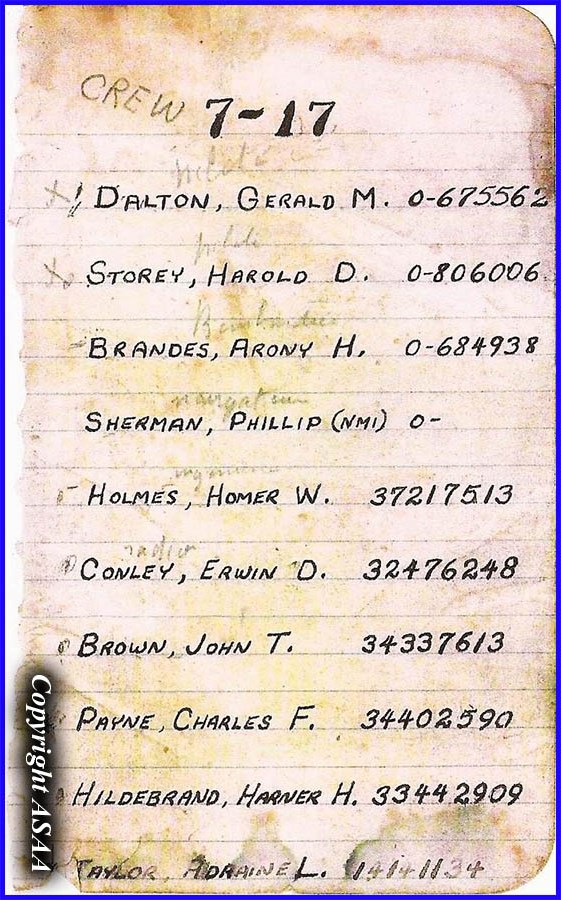
Page found around the wreck of the "Amblin' Okie".
Sgt. Charles F. Payne
Sgt. Charles F. Payne, waist gunner aboard the B-24 "Amblin' Okie", who was able to seize and don his parachute in time, is ejected and miraculously escapes the clutches of death.

Knowing that he is above a enemy occupied territory, Payne delays opening his parachute for as long as possible before landing in a ploughed field between the villages of Le Ployron and Frestoy-Vaux.
At the scene Marceau Durieux and a few Frenchmen run up to the airman who claims to be an American. There is no time to waste. Things have to be done very quickly before the Germans arrive. Once the parachute is buried in a furrow of the field, the airman is rushed over to the village of Le Ployron. For the moment, it is decided to hide him in the water tower.
Sgt. Payne slips inside, climbing the small iron ladder. He understands that his rescuers will return to him up later. Without giving any reason, Felix Midy, in charge of the installation, receives strict orders not to pump the water.
The airman stays clinging on all the afternoon, hearing at some point the Germans who are swarming the village looking for possible survivors.
Around 8:30 pm, the situation having somewhat calmed down, Marceau Durieux comes back to pick Sgt. Payne up. He was first taken to a barn and then inside a house where he is fed with bread and milk. He is also given warm wine, a surprising concoction that he cannot swallow. The language barrier makes conversation difficult but the airman makes it clear to his rescuers that he wants to go to Spain. It is through this country, then Gibraltar that he can reach England, according to the lectures received on the Wendling airbase. But for the moment he has to be patient, until his rescuers organize themselves.
Sgt Payne is then taken to an empty house in the village. The following evening, he is visited by Roger Levasseur, veteran of the Great War and at the head of the local Resistance. He declares to him that he is the only survivor and that the other 19 crew members have been buried in the village cemetery.
The bodies of the airmen found among the debris are gathered the same day in the church of Le Ployron. The Germans then give their agreement for them to be buried in the cemetery on condition that everything is ready for the next day.
The day of the funeral, many inhabitants gather near the church. Twenty coffins are manufactured in haste to make the enemy believe that there are no survivors. The Germans are very nervous. A machine gun is set up on the church square and Father Edouard Cousin is forbidden to celebrate the funeral. The situation is further aggravated when the Germans threaten to check the coffins. Then everything calms down thanks to Mrs Angele Laistre who manages to parley with them and the burial goes ahead.
Le Ployron - The church Father Edouard Cousin who officiated at the funerals

Le Ployron - The graves of the 19 airmen in the cemetery
The escape of Sgt.Charles F. Payne continues...
On the evening of Monday 20th March, Sgt. Charles F. Payne is taken to Tricot where he is taken in by the schoolmaster. The Resistance group of the St. Just-en-Chaussee area is notified of the presence of the surviving airman. Dr. Caudron, accompanied by Jean Crouet, has the job of picking up Sgt. Payne but in the night their car is damaged in a collision with a lorry. The transfer of the airman is postponed.
On the evening of Tuesday 21st March, it is finally Dr. Edmond Caillard who comes to pick Sgt. Payne up, taking him by car to his surgery of St. Just-en-Chaussee.
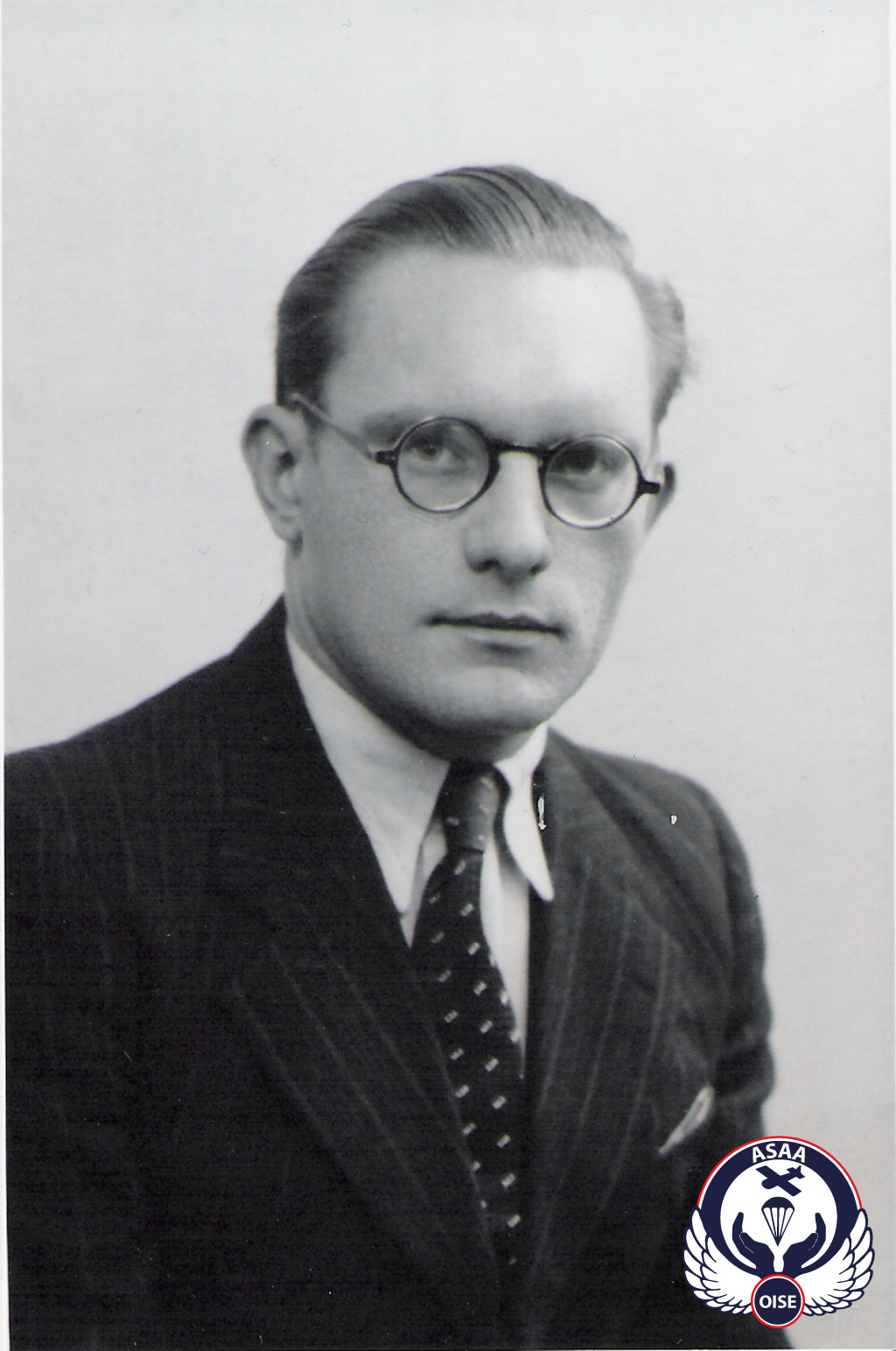
Dr. Edmond Caillard
Dr. Caillard then takes the airman to Jean Crouet, a chemical engineer. There, Sgt. Payne is surprised to meet a compatriot : S/Sgt. Eugene A. Colburn.
A native of Alabama, S/Sgt. Colburn was a gunner aboard a Flying Fortress of the 351st Bomb Group shot down on 24th February over the Somme. After wandering in the Picardy countryside, moving mostly at night, he reached the village of Mory-Montcrux (Oise) where he was taken in charge by Paul Maillard and his family. After a stay of about two weeks, John Stewart, a radio electrician and member of the Resistance of St. Just, came and took S/Sgt. Colburn by bicycle to Saint-Just-en-Chaussee.

On Wednesday 22nd March, Sgts Colburn and Payne are taken by Dr. Caillard to Bulles where they are lodged by Pierre Coulon. This carpenter had already put up American airmen the previous month. It is a reliable man and totally trustworthy. During the day, the two airmen must remain hidden in a small room on the second floor of the house overlooking the joinery. They only come down in the evening for dinner. The comings and goings of the Germans means the greatest care has to be taken.
Charles Payne and Eugene Colburn are then taken to Cressonsacq where they are housed in the farm of Henri and Simone Doisy. Jacky Pac, Intelligence Officer, comes to interrogate them to be certain they are indeed American airmen. He tells them that the Gestapo is making arrests in Paris and that they need to wait before continuing their escape.
About a week later, the two airmen are moved again. They are taken to Valere Sorel’s, a blacksmith who lives in Brunvillers-la-Motte with his wife Leonie and their daughter Lucie, aged 17. Charles F. Payne and Eugene A. Colburn remain under the protection of this family throughout all the month of April, in defiance of all the risks and of all the sacrifices in these times of great shortage.
Leonie, Lucie and Valere Sorel The house of the Sorel family at Brunvillers-la-Motte
A few days before the end of April, Dr. Caillard comes back to Brunvillers-la-Motte to get the two airmen. He takes them to Creil, to his friend and colleague, Dr. Georges Debray by whom he has many contacts. The important railway complex and the airfield occupied by the Germans causes the town to suffer many bombing raids.
The stay at Dr. Debray’s only lasts a few hours. Charles F. Payne and Eugene A. Colburn are led the same day to the village of Villers-Saint-Paul, a few kilometers from Creil. They are lodged by Suzanne Parizet.
During their stay in Villers-Saint-Paul, the two airmen again meet Jacky du Pac who has previously questioned them. He announces to them that they will leave in a few days. They also meet a teacher who brings them books and sometimes takes them to stretch their legs.
Some time later, the two airmen embark on a lorry and move to another village where they stay with an old man.
During the second half of May, they are taken by car to Chantilly, to a hotel near the railway station.
This hotel is used as a rendezvous point. They thus meet two Poles and two other American airmen : S/Sgt. Clifford G. Golke and Sgt. Cletus S. Hard, crewmembers of a Flying Fortress shot down on 10th April at Ercuis (Oise). Golke and Hard have previously stayed for five weeks with the Viet family in St. Vaast-les-Mello.
Two guides, (a man and a young woman), share the six men by dividing them into two groups of three. Payne, Colburn and Hard stay with the man while Golke and the two Poles follow the young woman. All then take the train to Paris.
Once at the Gare du Nord in Paris, the airmen rush into the metro and then stay in different apartments in the capital for several days.
On 30th May, they are brought to the Gare d’Austerlitz where they take a night train to the Southwest accompanied by two young women who serve as guides.
On 1st June, they arrive in Bordeaux. They are taken by car to the home of Jean Delfour, Chief of the Bordeaux Police. Two days later, grouped with other escapees, their trip resumes towards the mountains of the Pyrenees and Spain. Entrusted to “passeurs”, the long and difficult climb begins. They manage to cross the border in the evening of 4th June.
On the Spanish side, they are stopped by the Franco's Police. They are then interned in the camp of Miranda de Ebro.
Released, Payne, Colburn and Hard reach Gibraltar on 3rd July and then fly to Bristol, England, where they land on 4th July. All subsequently get back to the United States.
The Liberation
In early September 1944, American and British troops liberate the department of Oise.


Liberating US troops in Le Ployron
In the immediate postwar period, the inhabitants of Le Ployron pay homage to the airmen in the presence of US authorities. A plaque in their memory is laid at their graves.
To their disappointment, the graves of the 19 airmen are then taken away by the American Services. After identification, their remains are transferred to the Temporary Military Cemetery at Solers, in Seine-et-Marne.
At the request of their families, the bodies of 2nd Lts. Cummings, Greene, Storey, Sherman, T/Sgt. Dmoch, S/Sgts. Wolfer, Holmes, Conley, Sgts. Hildebrand and Taylor are repatriated to the United States.
2nd Lts. Feran, Hayes, Dalton, Brandes, S/Sgts. Wheeler, Hampton Jr, Gallagher, Boord and Sgt. Brown now rest in the American Military Cemetery at Epinal, in the Vosges.
Sgt. Charles F. Payne died on 2nd July 1990 at the age of 68. He is buried in the Arlington Cemetery, Virginia.

